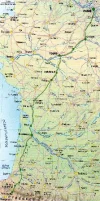oursonpolaire said:
I walked the Toulouse-Somport stretch in 2005 and was astonished at how few villages in France had any facilities at all (cafe, bar, restaurant, inn, grocery, anything). If it were not for the cemetery standpipes which provided potable water, I'd likely still be in a ditch somewhere outside Olorons Sainte Marie. Some of the French-language guides (the oddly-named Miam Miam Dodo) will help, but there is nothing like a) being prepared and b) consulting with locals on this.
Be prepared? I thought so too. But now just look at the consequence of my preparations. I have produced a notice which was kindly handed out in churches last Sunday by a friend in France, but a surprisingly prominent member of a French association
[I'll go no further in identifying him - at least publicly - to spare that organisation embarrassment, as they may wish to distance themselves from his attitude] wrote the following rant to me, for reasons known best to himself:
""I am sorry but you are WRONG !the ways of Santiago are ways of PROVIDENCE ! you DON'T NEED to make papers on the ways to find a room !!! IT S ABSOLUTLY WRONG AND IF YOU DO THIS you are a pilgrim, only a tourist, afraid of not to have what you need. AND you will be seen by others like a pilgrim !! YOU WANT TO MAKE THE PILGRIMAGE LIKE IN THE MIDDLE AGE???? SO DO IT !!!!!!!!! LIKE IN THE MIDDLE AGE In any cases, your stapes, your way in france is wrong too. like in sapain how can you know that this day you will be in this place ou this one??? any way.
"I am a member of ....
.[*DELETED TO SAVE EMBARRASSSMENT*] and I am the secretary of
[*DELETED*] so it's the mother of all the associations which exist.
"YOU WANT INFORMATIONS?? NO PROBLEM, but NOT in THE WAY YOU'RE MAKING YOUR WAY !!! PLEASE THINK ABOUT THAT !!! WHY ARE YOU REALLY GOING TO SANTIAGO??? IN WHAT DO YOU BELIEVE???? I TOLD THE WAYS OF SANTIAGO ARE WAYS OF PROVIDENCE.
"my job since several years, even i m not 40, is to hlep pilgrims, so I WILL DO IT WITH YOU or any body else, but please ! STOP TO BE AFRAID ! .... AND PLEASE STOP RIGHT NOW THESE COMMERCIALS ABOUT THE FACT TO SLEEP SOMEWHERRE "
So that's the sort of 'advice' you can expect from...
[a very prominent French pilgrim organisation] ...when planning your route through France. And the advice seems to be.. Errr... that you shouldn't be planning at all? (They may as well disband then!)
We record all the time in this forum our pleasant and uplifting experiences on the Camino, and it is mostly good news. But I have no hesitation in posting this story here - and good news this certainly isn't, on this rare occasion - because it needs to be recorded. As with any journey, there are hazards out there, ready to trip you up and give you a bad time, and we need to be aware of them. So it is important to record this, embarrassing and unsavoury though it may be for the organisation concerned. You know exactly who you are, so get your act together folks!
I am walking for a disabled children's charity and when this awful email came in during a planning session, I printed it out before reading it, thinking it was more "help" coming in from France. Some people read it before I realized what it contained and they were upset and amazed.
We have since been in touch with
non-Jacquarian walking associations in France to get the information needed and they are perfectly easy to talk to and very helpful, so that's the best thing now, to studiously avoid contact with those who 'speak' for the Chemin St Jacques and who are a little bit eccentric and unpredictable, to say the least :roll:
Has anyone else experienced this kind of thing, or do they just reserve this level of abuse for disabled children's charity fundraisers!
Gareth
P.S. I'm editing this post to say two things. Firstly, thank you to those who have responded privately to this post with some lovely, kind and supportive comments. I'll pass those on to the people at the charity I'm walking for. There's a really good positive online community on this Forum and pilgrims support each other wonderfully. That easily balances out the odd negative experience like that quoted above. (And it was
very odd, wasn't it?) Secondly, yes: I will name privately to any pilgrim who contacts me, exactly which organization is represented by the person I'm quoting here, if you wish to avoid encountering this level of rudeness! And you may be surprised when I tell you.




















